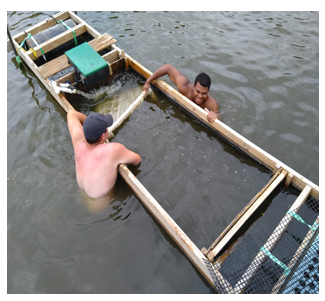FLOATING NURSERY RACEWAY PROOF OF CONCEPT FOR PRODUCTION OF PHASE I FINGERLING LARGEMOUTH BASS Micropterus salmoides
Intensive production of largemouth bass (LMB) requires production of fingerlings approximately one month old (phase I) for feed training. Intensive indoor systems are constrained by foods required by the fish. Dedicated nursery ponds can be managed for abundant food, but recovery of fish, weed problems, and damage during harvest are issues. Cannibalism may occur if fry of different sizes from different spawns are stocked together. In this study, a floating raceway was designed as a nursery for LMB giving them access to natural food from the pond, while being confined in the raceway.
Three floating nursery raceways with a volume of 1700 L, designed and constructed for production of phase I LMB were each placed in a separate 0.1-acre pond. Three 0.1-acre ponds were managed as a control treatment. All six ponds were fertilized with organic (chicken crumbles and soybean meal) and inorganic (18-46-0) fertilizer to produce an abundant plankton bloom as food for the LMB. Fish were not fed a prepared diet. An electric pump delivered a flow of plankton rich pond water at 57 L/min into each raceway. Each pond and raceway unit was stocked with 6,000 fry, seined, then drained at harvest.
Mean recovery of LMB fingerlings after 27 days was 98% from nursery ponds and 41% (range 1.6 to 77%) inside the floating raceway and 48% outside the raceway. Average weight of fish was 1.4 g in ponds, 0.7 g inside, and 1.7 g outside the raceway. Though growth trended higher in ponds variation within treatment was great, making it impossible to demonstrate statistical significance.
The floating nursery successfully produced phase I LMB, but escapement and food availability arose as issues that can be addressed. Harvesting fish in the floating nursery (photo) took less labor and was faster than harvesting the fish in a pond. The suspended floating raceway design used in this study has no docks or posts. It is easily constructed with cost for materials of approximately $500/unit.
